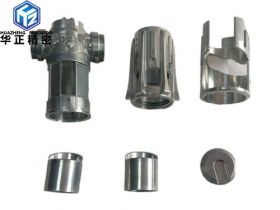Technology Center
Recommended Products
Contact Us
Contact Person: Cindy Zhu
TEL:+86 13418453374
Deburring process in machining
Deburring process in machining
Those who are struggling in the metal industry need to be familiar with Bali. Burrs are ubiquitous in the processing of metal products. No matter how sophisticated and sophisticated the equipment is, it comes with the product. So-called burrs are a type of excess iron powder that is generated at the processed edges of processed materials, mainly due to plastic deformation of materials, especially materials with good ductility and toughness that are prone to burrs. The number of is the metal processing industry. This is one of the problems that engineers have never been able to solve.
The types of burrs in the metalworking process are mainly flash burrs, sharp burrs, splashes, etc., and there is a significant excess metal residue that does not meet the product design requirements. So far, there is no effective way to eliminate this problem in the manufacturing process, so engineers must work hard to eliminate the latter to ensure product design requirements, but so far. By the way, it's different There are many methods and equipment for removing burrs.
Under normal circumstances, deburring methods can be divided into four categories: coarse (hard contact) including cutting, grinding, filing, scraping, etc .; normal grade (soft contact): belongs to this category There is belt grinding , Grinding, elastic wheel grinding and polishing, etc .; Precision level (flexible contact): This category includes cleaning treatment, electrotechnical treatment, point solution grinding and rolling treatment, etc .; Ultra-precision level (precision contact): Included in this category are Abrasive Flow Deburring, Magnetic Abrasive Deburring, Thermal Deburring, and Powerful Ultrasonic Deburring with High Density Radium. With this type of deburring method, sufficient part machining accuracy can be obtained.
When choosing a deburring method, many factors need to be considered, such as material properties, structural shape, part size and accuracy, especially surface roughness, dimensional tolerances, deformation, and residual stress. So-called point solution deburring is a method of chemical deburring. It removes burrs after machining, grinding and stamping and can round sharp edges of metal parts. Electrochemical machining that uses electrolysis to remove burrs on metal parts. In English it is called ECD. Secure the tool cathode (usually brass) near the burr on the workpiece with a constant gap (usually 0.3-1 mm) between the two. Align the conductive part of the tool's cathode with the edge of the burr and cover the other side with an insulating layer to concentrate the electrolysis on the burr. During processing, the cathode of the tool is connected to the negative electrode of the DC power supply and the work piece is connected to the positive electrode of the DC power supply. A low pressure electrolyte (usually sodium nitrate or sodium chlorate aqueous solution) with a pressure of 0.1-0.3 MPa flows between the workpiece and the cathode. When the DC power is turned on, the burrs are dissolved and removed by the anode and removed by the electrolyte.
Since the electrolyte is corrosive to some extent, clean the work after deburring and perform rust prevention treatment. Electrochemical deburring is suitable for removing burrs from cross holes in hidden or complex shaped parts. It is highly efficient and usually takes only a few seconds to a few tens of seconds to deburr. This method is often used for deburring gears, splines, connecting rods, valve bodies, crankshaft oil passages, and rounding sharp corners. The disadvantage is that the parts near the burrs are also electrolyzed, causing the surface to lose its original luster and even affect dimensional accuracy. Of course, in addition to electrolysis to remove burrs, there are the following methods to remove burrs.
1. Abrasive Flow Deburring: Abrasive Flow Machining Technology (AFM) is a new finishing deburring process that was not developed abroad in the 1970s. This process is especially suitable for burrs that have just entered the finishing stage, but small and small long bottom holes and dies are not suitable for machining.
2. Magnetic grinding deburring: This method began in the 1960s in Eastern European countries such as the former Soviet Union and Bulgaria. In the mid-1980s, Nikkei and its mechanisms and applications were studied in detail. In magnetic grinding, the workpiece is placed in a magnetic field formed by two magnetic poles, the magnetic abrasive is placed in the gap between the workpiece and the magnetic poles, and the abrasive is neatly placed along the direction of the magnetic field. The force of the magnetic field forms a soft and hard magnetic grinding When the workpiece vibrates axially in the rotating shaft in the magnetic field, the workpiece and abrasive move to each other and the polishing brush grinds the surface of the workpiece. Magnetic grinding allows parts to be ground and deburred efficiently and quickly. It is suitable for parts of various materials, sizes and structures, with low investment, high efficiency, wide range of applications and high quality finishing methods. Currently, overseas, the inner and outer surfaces of rotating bodies, flat parts, gear teeth, complex profiles, etc. are ground and deburred, wires and wire oxide skins are removed, and printed circuit boards are cleaned.
3. Thermal deburring: Thermal deburring (TED) is the burning of burrs at high temperatures generated by the detonation of a mixture of hydrogen and oxygen gas or natural gas. Check by putting oxygen or natural gas and oxygen in a closed container. After igniting with a spark plug, it explodes in an instant and releases a large amount of heat energy to remove burrs. However, after burning the workpiece, the gas-oxidized powder adheres to the surface of the workpiece and must be washed or pickled.
4. Mi Lei's powerful ultrasonic deburring: Mi Lei's powerful ultrasonic deburring technology is a popular deburring method in recent years. The included cleaning efficiency is 10 to 20 times that of a normal ultrasonic cleaner, and the air is uniform. sink. Due to its high density dispersion, ultrasonic waves can be completed simultaneously within 5-15 minutes without the use of cleaning agents.
















